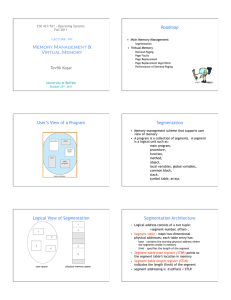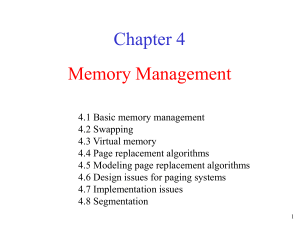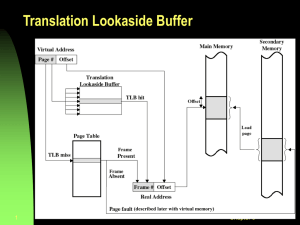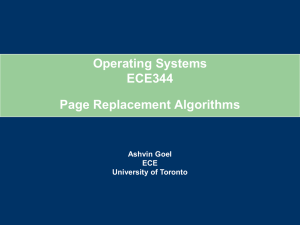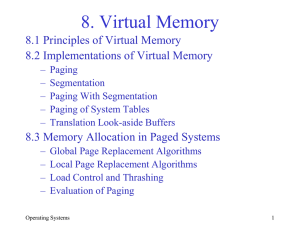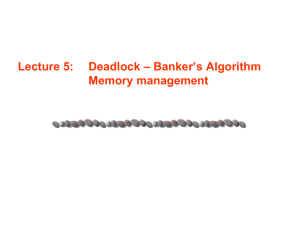Chapter 8 Virtual Memory
advertisement
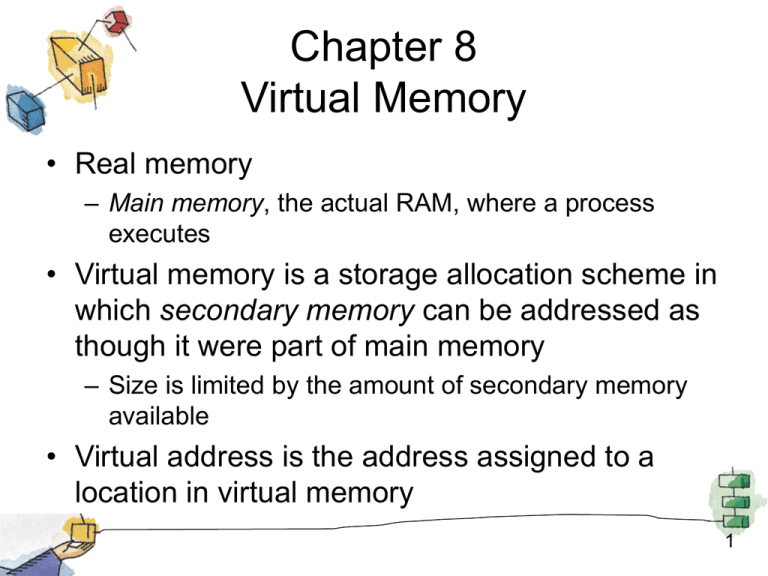
Chapter 8 Virtual Memory • Real memory – Main memory, the actual RAM, where a process executes • Virtual memory is a storage allocation scheme in which secondary memory can be addressed as though it were part of main memory – Size is limited by the amount of secondary memory available • Virtual address is the address assigned to a location in virtual memory 1 Keys to Virtual Memory 1) Memory references are logical addresses that are dynamically translated into physical addresses at run time – A process may be swapped in and out of main memory, occupying different regions at different times during execution 2) A process may be broken up into pieces (pages or segments) that do not need to be located contiguously in main memory 2 Breakthrough in Memory Management • If both of those two characteristics are present, – then it is not necessary that all of the pages or all of the segments of a process be in main memory during execution. • If the next instruction and the next data location are in memory then execution can proceed 3 Execution of a Process • OS brings into main memory a few pieces of the program – Resident set: portion of process that is in main memory • Execution proceeds smoothly as long as all memory references are to locations that are in the resident set • An interrupt (memory access fault) is generated when an address is needed that is not in main memory 4 Execution of a Process • OS places the process in a blocking state • Piece of process that contains the logical address is brought into main memory – OS issues a disk I/O Read request – Another process is dispatched to run while the disk I/O takes place – An interrupt is issued when disk I/O complete which causes OS to place the affected process in the Ready state 5 Implications of this new strategy • More efficient processor utilization – More processes may be maintained in main memory because only load in some of the pieces of each process – More likely a process will be in the Ready state at any particular time • A process may be larger than main memory – This restriction in programming is lifted – OS automatically loads pieces of a process into main memory as required 6 Thrashing • A condition in which the system spends most of its time swapping pieces rather than executing instructions. • It happens when OS frequently throws out a piece just before it is used • To avoid this, OS tries to guess, based on recent history, which pieces are least likely to be used in the near future. 7 Principle of Locality • Program and data references within a process tend to cluster only a few pieces of a process will be needed over a short period of time • It is possible to make intelligent guesses about which pieces will be needed in the future, which avoids thrashing • This suggests that virtual memory may work efficiently 8 Performance of Processes in VM Environment • During the lifetime of the process, references are confined to a subset of pages. 9 Support Needed for Virtual Memory • Hardware must support paging and segmentation • OS must be able to manage the movement of pages and/or segments between secondary memory and main memory 10 Paging • Each process has its own page table • Each page table entry contains the frame number of the corresponding page in main memory • Two extra bits are needed to indicate: – P(resent): whether the page is in main memory or not – M(odified): whether the contents of the page has been altered since it was last loaded 11 Paging Table • It is not necessary to write an unmodified page out when it comes to time to replace the page in the frame that it currently occupies 12 Address Translation The frame no. is combined with the offset to produce the real address The page no. is used to index the page table and look up the frame no. 13 Page Tables • Page tables can be very large – Consider a system that supports 231=2Gbytes virtual memory with 29=512-byte pages. The number of entries in a page table can be as many as 222 • Most virtual memory schemes store page tables in virtual memory • Page tables are subject to paging 14 Two-Level Hierarchical Page Table Composed of 210 4byte page table entries Composed of 220 4byte page table entries, occupying 210 pages is composed of 220 4-kbyte (212) pages 15 Address Translation for Hierarchical page table The root page always remains in main memory 16 Translation Lookaside Buffer • Each virtual memory reference can cause two physical memory accesses – One to fetch the page table – One to fetch the data • To overcome this problem a high-speed cache is set up for page table entries – Called a Translation Lookaside Buffer (TLB) – Contains page table entries that have been most recently used 17 Translation Lookaside Buffer 18 TLB operation By the principle of locality, most virtual memory references will be to locations in recently used pages. Therefore, most references will involve page table entries in the cache. TLB hit TLB miss 19 Page Size • Page size is an important hardware design decision • Smaller page size less amount of internal fragmentation more pages required per process larger page tables some portion of page tables must be in virtual memory double page fault (first to bring in the needed portion of the page table and second to bring in the process page) 20 Page Size • Large page size is better because – Secondary memory is designed to efficiently transfer large blocks of data 21 Further complications to Page Size • Small page size a large number of pages will be available in main memory for a process as time goes on during execution, the pages in memory will all contain portions of the process near recent references low page fault rate 22 Further complications to Page Size • Increased page size causes pages to contain locations further from any recent reference the effect of the principle of locality is weakened page fault rate rises 23 Example Page Size •The design issue of page size is related to the size of physical main memory and program size. •At the same time that main memory is getting larger, the address space used by applications is also growing. architectures that support multiple page sizes 24 Segmentation • Segmentation allows the programmer to view memory as consisting of multiple address spaces or segments. • Segments may be of unequal size. • Each process has its own segment table. 25 Segment Table • A bit is needed to determine if segment is already in main memory, if present, – Segment base is the starting address of the corresponding segment in main memory – Length is the length of the segment • Another bit is needed to determine if the segment has been modified since it was loaded in main memory 26 Address Translation in segment base Segmentation The is added to the offset to produce the real address The segment no. is used to index into the segment table and look up the segment base 27 Combined Paging and Segmentation • A user’s address space is broken up into a number of segments and each segment is broken into fixed-size pages • From the programmer’s point of view, a logical address still consists of a segment number and a segment offset. • From the system’s point of view, the segment offset is viewed as a page number and page offset 28 Combined Paging and Segmentation • The base now refers to a page table. 29 Address Translation The frame no. is The page no. is used to index the page table and look up the frame no. combined with the offset to produce the real address The segment no. is used to index into the segment table to find the page table for that segment 30 Key Design Elements • • • • • Fetch policy Placement policy Replacement policy Cleaning policy Key aim: Minimise page faults – No definitive best policy 31 Fetch Policy • Determines when a page should be brought into memory • Demand paging – only brings pages into main memory when a reference is made to a location on the page – many page faults when process first started • Prepaging – pages other than the one demanded by a page fault are brought in. – more efficient to bring in pages that reside contiguously on the disk 32 Placement Policy • Determines where in real memory a process piece is to reside • Important in a segmentation system such as best-fit, first-fit, and etc are possible alternatives • Irrelevant for pure paging or combined paging with segmentation 33 Replacement Policy • When all of the frames in main memory are occupied and it is necessary to bring in a new page, the replacement policy determines which page currently in memory is to be replaced. • But, which page is replaced? 34 Replacement Policy • Page removed should be the page least likely to be referenced in the near future – How is that determined? • Most policies predict the future behavior on the basis of past behavior • Tradeoff: the more sophisticated the replacement policy, the greater the overhead to implement it 35 Replacement Policy Frame Locking • Frame Locking – If frame is locked, it may not be replaced – Kernel of the operating system – Key control structures – I/O buffers – Associate a lock bit with each frame which may be kept in a frame table as well as being included in the current page table 36 Optimal policy • Selects for replacement that page for which the time to the next reference is the longest • Results in the fewest number of page faults but it is impossible to have perfect knowledge of future events • Serves as a standard to judge real-world algorithms 37 Optimal Policy Example • The optimal policy produces three page faults after the frame allocation has been filled. 38 Least Recently Used (LRU) • Replaces the page that has not been referenced for the longest time • By the principle of locality, this should be the page least likely to be referenced in the near future • Difficult to implement – One approach is to tag each page with the time of last reference. – This requires a great deal of overhead. 39 LRU Example • The LRU policy does nearly as well as the optimal policy. – In this example, there are four page faults 40 First-in, first-out (FIFO) • Treats page frames allocated to a process as a circular buffer • Pages are removed in round-robin style – Simplest replacement policy to implement • Page that has been in memory the longest is replaced – But, these pages may be needed again very soon if it hasn’t truly fallen out of use 41 FIFO Example • The FIFO policy results in six page faults. – Note that LRU recognizes that pages 2 and 5 are referenced more frequently than other pages, whereas FIFO does not. 42 Clock Policy • Uses an additional bit called a “use bit” • When a page is first loaded in memory or referenced, the use bit is set to 1 • When it is time to replace a page, the OS scans the set flipping all 1’s to 0 • The first frame encountered with the use bit already set to 0 is replaced. • Similar to FIFO, except that, any frame with a use bit of 1 is passed over by the algorithm. 43 Clock Policy Example incoming page 727 44 Clock Policy Example An asterisk indicates that the corresponding use bit is equal to 1. The arrow indicates the current position of the pointer. • Note that the clock policy is adept at protecting frames 2 and 5 from replacement. 45 Replacement Policy Comparison Two conflicting constraints: 1. We would like to have a small page fault rate in order to run efficiently, 2. We would like to keep a small frame allocation. 46 Page Buffering • Replacing a modified page is more costly than unmodified page because the former must be written to secondary memory • Solution: page buffering + FIFO – Replaced page remains in memory (only the entry in the page table for this page is removed) and is added to the tail of one of two lists • Free page list if page has not been modified • Modified page list if it has 47 Page Buffering • The free page list is a list of page frames available for reading in pages. • When a page is to be read in, the page frame at the head of the list is used, destroying the page that was there. • The important aspect is that the page to be replaced remains in memory. – If the process references that page, it is returned to the resident set of that process at little cost. – In effect, the free and modified page lists act as a cache of pages. 48 Cleaning Policy • A cleaning policy is concerned with determining when a modified page should be written out to secondary memory. • Demand cleaning – A page is written out only when it has been selected for replacement – Minimizes page writes – A process that suffers a page fault may have to wait for two page transfers before it can be unblocked decrease processor utilization 49 Cleaning Policy • Precleaning – Pages are written out in batches (before they are needed) – Reduces the number of I/O operations – Pages written out may have been modified again before they are replaced waste of I/O operations with unnecessary cleaning operations 50 Cleaning Policy • Better approach: incorporates page buffering • Cleans only pages that are replaceable – decouples the cleaning and replacement operations • Pages in the modified list are periodically written out in batches and moved to the free list – significantly reduces the number of I/O operations and therefore the amount of disk access time • Pages in the free list are either reclaimed if referenced again or lost when its frame is assigned to another page 51
